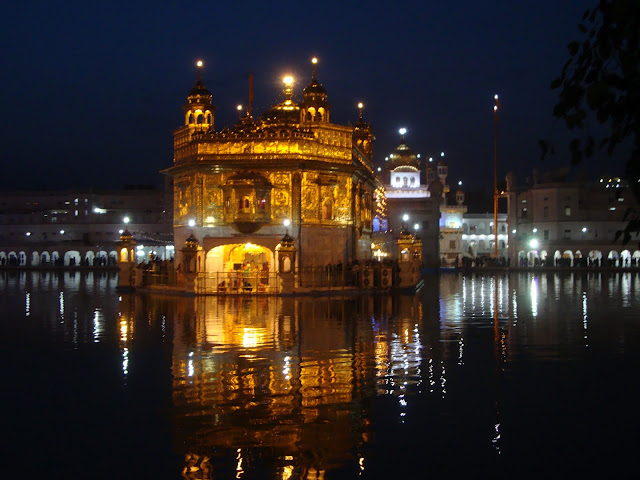People stand for the sunset prayers. In the evening the golden temple seems to be lit from within, glowing with a golden light that is reflected in the shimmering lake. The singers are singing the Sikh scriptures, which appear, translated on a screen in a corner of the courtyard. The scriptures are beautifully poetic and many devotees know them by heart.
I met a young French man who is travelling the world with only enough money to pay for visas. He hitchhikes and accepts food that is offered to him. He sleeps in a tent, or is invited into people’s houses. In Turkey and Iran people invited him to stay wherever he went. He left France with 250 euros and he still has 100 euros. In India he can sleep and eat in Sikh temples and work in the kitchen as payment. He plans to boat hitch hike his way through Malaysia and Indonesia.
The temple inn is a three storey building with balconies, where the pilgrims hang their washing, round a square courtyard. All the rooms are dormitories, with beds lined up in rows, touching. They are covered by one long sheet that time doesn’t look as if it has been changed for a long time. At times like this I am glad of my sleeping bag.
In the evening they lay long felt mats in the courtyard of the inn for all the pilgrims who arrived too late for a place in a dormitory. They are provided with thick quilts to lie on and to cover themselves with. Soon the whole courtyard is a bumpy sea of quilt-covered bodies.
I visited the Sikh museum, which is full of gory paintings of Sikh martyrs, who died horribly, tortured to death by Muslims in the seventeenth and eighteenth centuries. There is no mention of what the Sikhs did to the Muslims. Then there were the British massacres, which were not particularly directed against the Sikhs, but some Sikhs were caught up in them. And then there is a photo of the temple destroyed by Indira Ghandi, after which her Sikh bodyguards killed her. Terrible massacres of Sikhs occurred all over India after that.
The Sikhs are a war-like people, who carry ceremonial daggers, swords and spears. They fought for the British during the two world wars.
I joined a queue of Sikh devotees and was pushed along towards the inside of the temple, where the singers and their tabla players sit together in a black turbaned group. The intricate gold leaf tracery of leaves and the marble walls with their semi-precious stone inlay of flowers all remind me of Mughal architecture and art. In all the battle scenes in the museum I could never make out who was Sikh and who was Muslim. They all wore turbans and brandished their swords fiercely. The wars between the Sikhs and Mughal Muslims went on for centuries in Punjab and Rajasthan and most for a long time the Mughals had the upper hand, but at one point the Sikhs managed to gain a fair sized piece of territory, where they built palaces and called themselves Maharajas. Today the Sikhs live on the border with Pakistan, presumably ready to protect it, should their age-old enemies the Muslims invade.

No comments:
Post a Comment